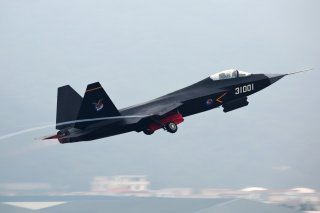China Is Getting Ready to Unveil Its Answer to the Carrier-Launched F-35
The nascent Chinese carrier-launched 5th-generation capability may now fall well short of being able to rival the United States, yet the ability of China to project stealthy air attack power from the ocean is something the Pentagon is likely to take quite seriously.
China will soon reveal its first-ever carrier-launched, 5th-generation stealth fighter jet to project power offshore and attempt to rival the U.S. F-35B and F-35C.
For quite some time, speculation and reporting have been mounting that China has been fast developing a carrier-launched variant of its J-31 5th-generation stealth aircraft. A recent report in the Chinese government-backed Global Times newspaper wrote that the new stealth fighter will emerge “this year.” The paper quotes the chief designer of the FC-31 saying “this year, people should be able to see good news on the next-generation aircraft carrier-based fighter jet. When the aircraft is ready, people will get to see it.”
According to previously published photos, the configuration of the FC-31 looks very much like an F-35 design “rip-off.” However, little is known of its actual performance characteristics regarding speed, targeting, weapons, and sensors, so there is little available basis upon which to compare it to an actual F-35.
One interesting dynamic to note is that China only operates two aircraft carriers, and while they have plans to rapidly add several more, the numbers of carriers and numbers of yet-to-be-formally produced carrier-launched FC-31s will have a long way to go before being able to present any kind of credible counterbalance to the U.S. Navy and Marine Corps.
The Navy, for example, operates as many as eleven aircraft carriers and plans to acquire as many as 273 F-35Cs. Added to this equation is the F-35B, an aircraft for which the Chinese do not appear to have an equivalent. Unlike the larger F-35C which needs a carrier runway, the F-35B can travel on amphibious assault vehicles and perform vertical take-off and landing. This introduces previously unprecedented tactical advantages for 5th-generation maritime attack and amphibious operations.
The small number of Chinese carriers, coupled with the lack of any kind of F-35B aircraft able to take off from smaller ships, would seem to make it quite difficult for the People’s Liberation Army Navy to compete with the United States in any kind of measurable way. Overall, however, China now operates more ships than the U.S. Navy and has long operated its carrier-based J-15 fighter jet.
However, the nascent Chinese carrier-launched 5th-generation capability may now fall well short of being able to rival the United States, yet the ability of China to project stealthy air attack power from the ocean is something the Pentagon is likely to take quite seriously. At the very least, the development will help China accomplish its near-term goal of quickly expanding beyond being purely a regionally dominant power into a large-scale global power with substantial international reach. Air attack from the sea possibilities, especially 5th-generation airpower, introduces the ability to hold areas at risk in ways that have previously been completely impossible.
Kris Osborn is the defense editor for the National Interest. Osborn previously served at the Pentagon as a Highly Qualified Expert with the Office of the Assistant Secretary of the Army—Acquisition, Logistics & Technology. Osborn has also worked as an anchor and on-air military specialist at national TV networks. He has appeared as a guest military expert on Fox News, MSNBC, The Military Channel, and The History Channel. He also has a Master's Degree in Comparative Literature from Columbia University.
Image: Wikimedia Commons

